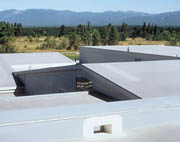When will ASTM issue a TPO Standard?
The American Society for Testing and Materials, continues to ballot its D-8 committee membership to form a consensus standard for a TPO membrane. It is felt that most technical issues have been resolved, and ASTM should accept the TPO Standard later in 2002. Like most consensus standards, the road to an acceptable standard has been a long process with many compromises. The most difficult part may very well have been in defining what encompasses a TPO product in terms of its material composition, thickness and reinforcement.
How durable is a TPO membrane?
The American Society for Testing and Materials, continues to ballot its D-8 committee membership to form a consensus standard for a TPO membrane. It is felt that most technical issues have been resolved, and ASTM should accept the TPO Standard later in 2002. Like most consensus standards, the road to an acceptable standard has been a long process with many compromises. The most difficult part may very well have been in defining what encompasses a TPO product in terms of its material composition, thickness and reinforcement.What are the environmental issues?
The environmental issues can be divided into two segments: manufacture and proper disposal. In regards to manufacturing, current TPO membranes can now be assembled in a single manufacturing step using a coextrusion process, reducing by two-thirds the energy required to produce it.* Better production methods and process controls also reduce waste and out-of-spec material.
In terms of disposal, many of today’s TPOs use a mineral-hydrate flame retardant. This is far friendlier to the environment than the bromine-based flame retardant that was replaced. Being a polyolefin-based product, TPOs are the most environmentally friendly roofing membranes through manufacture, use and disposal.
What are the keys to TPO application?
TPOs are generally harder to apply than PVCs because they have a stiffer feel than a PVC sheet of similar weight and thickness. Unlike PVC, an aged TPO sheet cannot be re-worked or repaired as easily. This obviously places a high premium on getting the seam right the first time.A major concern for the inexperienced seam welder is how to determine if a proper seam has been formed or if it is only a “cold” weld. Of course, the ultimate teacher is experience by making and checking seams. An experienced welder will probe the seam to verify its strength. When making a weld, and especially with a motorized welder, a sample should be taken and tested at the beginning and after every 100 feet to determine if the weld has been done properly. A proper weld will tear to either side of the weld but not in it.
If rooftop conditions change or if the welder is shut down and restarted, then another sample should be taken and tested. The advantages of a thermoplastic membrane (PVC and TPO) are that samples can easily be taken and a permanent patch installed over the tested area. When using a motorized welder, placing a welding guide, such as a narrow strip of walk board, along side the seam can help prevent membrane wrinkling and fishmouths at the seam.
The temperature range for welding TPO is narrower than for PVC. If the motorized welder is too hot or too slow, it’s very likely that the sheet will overheat or even burn. If the welder is too cold or the application is too fast, the seam will likely be a cold or temporary weld. Changes in ambient temperature, such as from morning to noon will affect the TPO weld more than it would PVC.
When probing a TPO seam, it is best to wait a few days because it is then easier to detect a marginal seam from a proper one. Care must be exercised when probing a TPO seam so as not to be overly aggressive and damage it. Since TPO seams do not set up the same as PVC, there isn’t the typical “bleed-out” of a PVC seam, which many welders have used as their indicator that the seam is a proper one. The welder must develop familiarity with how a proper TPO seam looks and feels.
The surface texture of the sheet also can influence the strength of the weld. Rough or uneven surfaces may bond only on their high points and not be fully adhered to each other. Rough surfaces usually require more heat to affect a proper weld. Of course, it is equally important to avoid using too much heat, which will lead to other problems. The applicator must have the experience to know how much heat to apply and for how long.
Another cold-weather application concern is the relative stiffness of the TPO sheet, making it more difficult to work with than a PVC sheet. This is a particular concern with flashing details, such as fitting it into corners and other tight areas. While creasing it apparently does not harm the sheet, once a TPO sheet has been bent or creased, the crease becomes permanent.
Do white colored TPOs qualify for an Energy Star rating?
The Energy Star rating is a measure of solar reflectance of a membrane’s surface. A white or light-colored TPO membrane can qualify for the Energy Star rating as long as it has been tested and the results accepted by the EPA. The membrane must achieve a solar reflectance of 0.65 or greater for a new sheet and 0.50 or greater for a sheet aged for three years.White or light-colored sheets have been measured to be 50 to 60 degrees F cooler than black or dark-colored sheets. Using light-colored sheets should significantly reduce the heat load on one and two story buildings.
*Sharp, Stephen A., “TPOs-Commodity or specialty?”, Professional Roofing, June 2002
Report Abusive Comment